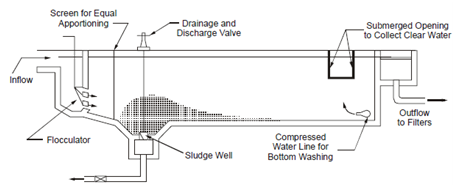Impurities removal in sedimentation:
The quantum of impurities removal in sedimentation tank depends on several factors:
(a) Size, shape, density and nature (discrete or flocculant) of the particles.
(b) Viscosity, density and temperature of water.
(c) Surface overflow rate.
(d) Velocity of flow.
(e) Inlet and outlet arrangements.
(f) Detention period.
(g) Effective depth of settling zone.
However, it has been estimated that plain sedimentation tank removes about 60% of suspended and 70% of bacterial load from water. Sedimentation tank are classified as:
- fill and draw type (also known as batch process), and
- Continuous flow type.
Continuous types are most popular. Depending on their shape, they are classified as:
- Circular,
- Rectangular, and
- Square.
Depending on the direction of flow, sedimentation tanks are classified as:
- Horizontal flow - longitudinal or radial flow, and
- Vertical flow - circular (upward flow).
Figure depicts cross-section of typical horizontal flow sedimentation tank.

Figure: Cross-section of Typical Horizontal Flow Sedimentation Tank